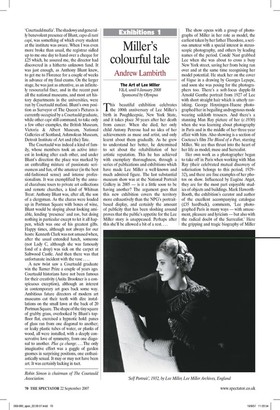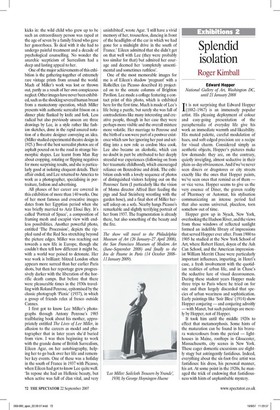Miller's colourful tale
Andrew Lambirth The Art of Lee Miller V&A, until 6 January 2008 Sponsored by Olympus This beautiful exhibition celebrates the 100th anniversary of Lee Miller's birth in Poughkeepsie, New York State, and it takes place 30 years after her death from cancer. When she died, her only child Antony Penrose had no idea of her achievements as muse and artist, and only learnt about them gradually. As he grew to understand her better, he determined to set about the rehabilitation of her artistic reputation. This he has achieved with exemplary thoroughness, through a series of publications and exhibitions which have made Lee Miller a well-known and much admired figure. The last substantial museum show was at the National Portrait Gallery in 2005 — is it a little soon to be having another? The argument goes that this new exhibition covers the territory more exhaustively than the NPG's portraitbased display, and certainly the amount of publicity that has been sloshing around proves that the public's appetite for the Lee Miller story is unappeased. Perhaps after this she'll be allowed a bit of a rest....
The show opens with a group of photographs of Miller in her role as model, the earliest taken by her father Theodore, a serious amateur with a special interest in stereoscopic photography, and others by leading names of the period. Conde Nast grabbed Lee when she was about to cross a busy New York street, saving her from being run over and at the same time recognising her model potential. He stuck her on the cover of Vogue in a drawing by Georges Lepape, and soon she was posing for the photographers too. There's a soft-focus dapple-lit Arnold Genthe portrait from 1927 of Lee with short straight hair which is utterly ravishing. George Hoyningen-Huene photographed her in beguiling androgynous mode wearing sailcloth trousers. And there's a stunning Man Ray picture of her (c.1930) when she was learning about photography in Paris and in the middle of her three-year affair with him Also showing is a section of Cocteau's film The Blood of a Poet, starring Miller. We are thus thrust into the heart of her life as model, muse and Surrealist.
Her own work as a photographer began to take off in Paris when working with Man Ray (their celebrated mutual discovery of solarisation belongs to this period, 192932), and there are fine examples of her photos on show. Influenced by Eugene Atget, they are for the most part enjoyable studies of objects and buildings. Mark HaworthBooth, the exhibition's curator and author of the excellent accompanying catalogue (05 hardback), comments, 'Lee photographed Paris in many ways — with amusement, pleasure and lyricism — but also with the radical doubt of the Surrealist.' Here the gripping and tragic biography of Miller kicks in: the wild child who grew up to be such an extraordinary person was raped at the age of seven by a family friend who gave her gonorrhoea. To deal with it she had to undergo painful treatment and a decade of psychological counselling. No wonder the anarchic scepticism of Surrealism had a deep and lasting appeal to her.
One of the major achievements of this exhibition is the gathering-together of extremely rare vintage prints from around the world. Much of Miller's work was lost or thrown out, partly as a result of her own conspicuous neglect. Other images have never been exhibited, such as the shocking severed human breast from a mastectomy operation, which Miller presents with authentic surrealist frisson on a dinner plate flanked by knife and fork. Less radical but also previously unseen are three drawings by Lee, in a style rather like fashion sketches, done in the rapid assured notation of a theatre designer conveying an idea. (Miller studied experimental theatre design in 1925.) Two of the best surrealist photos are of asphalt poured on to the road in strange biomorphic shapes. Lee learnt from Man Ray about cropping, rotating or flipping negatives for more surprising results, and she is particularly good at isolating eloquent details. Their affair ended, and Lee returned to America to work as a photographer, specialising in portraiture, fashion and advertising.
All phases of her career are covered in this exhibition of more than 140 works. One of her most famous and evocative images dates from her Egyptian period when she was briefly married to Aziz Eloui Bey. It's called 'Portrait of Space', a composition of framing mesh and escapist view with endless possibilities. Another powerful photo, entitled 'The Procession', depicts the rip pled sand of the Red Sea stretching beyond the picture edges. Miller was reaching out towards a new life in Europe, though she couldn't then tell how different it might be, with a world war poised to detonate. Her war work is brilliant: blitzed London often appears more surreal than her earlier Paris shots, but then her reportage grew progressively darker with the liberation of the horrific death camps. But before that there were pleasurable times in the 1930s travelling with Roland Penrose, epitomised by the classic photograph 'Picnic' (1937), in which a group of friends relax al fresco outside Cannes.
I first got to know Lee Miller's photographs through Antony Penrose's 1985 trailblazing book about his mother, appropriately entitled The Lives of Lee Miller, in allusion to the careers as model and photographer that in later years she'd buried from view. I was then beginning to work with the grande dame of British Surrealism, Eileen Agar, on her autobiography, helping her to go back over her life and remember key events. One of these was a holiday in the south of France in 1937 with Picasso, when Eileen had got to know Lee quite well. 'In repose she had an Hellenic beauty, but when active was full of élan vital, and very uninhibited', wrote Agar. 'I still have a vivid memory of her, trouserless, dancing in front of the headlights of the car in which we had gone for a midnight drive in the south of France.' Eileen admitted that she didn't get on that well with Lee (they were probably too similar for that) but admired her courage and deemed her 'completely unsentimental and sometimes ruthless'.
One of the most memorable images for me is of Eileen's shadow 'pregnant' with a Rolleiflex (as Picasso described it) projected on to the ornate columns of Brighton Pavilion. Lee made a collage featuring a contact print of this photo, which is exhibited here for the first time. Much is made of Lee's life being a puzzle, but surely she was full of contradictions like many interesting and creative people, though in her case they were perhaps more visible and the overall mixture more volatile. Her marriage to Penrose and the birth of a son were part of a postwar existence which saw her ignoring her past and settling into a new role as cordon bleu cook. Lee also became an alcoholic, which can no doubt in part be attributed to her deeply stressful war experiences (following on from her traumatic childhood), which encouraged reliance on Benzedrine and drink. The exhibition ends with a lovely sequence of photos of distinguished visitors helping out on the Penroses' farm (I particularly like the vision of Moma director Alfred Barr feeding the pigs and Saul Steinberg wrestling with the garden hose), and a final shot of Miller herself asleep on a sofa. Nearby hangs Picasso's remarkable and slightly terrifying portrait of her from 1937. The fragmentation is already there, but also something of the beauty and the fire.
The show will travel to the Philadelphia Museum of Art (26 Janucny-27 April 2008), the San Francisco Museum of Modem Art (June–September 2008) and finally to the Jeu de Paume in Paris ( 14 October 200811 January 2009).


































































 Previous page
Previous page